-


Implant-supported removable restorations in the edentulous jaw
Wolfart, Stefan / Weber, VolkerOutline: - Patient presentation, impression, comprehensive jaw relation records - Wax-up, Fabrication of the provisional restoration - Fabrication of a DVT based planning and drilling template - Surgical procedures for inserting four implants in the mandible - Suturing and relining of the existing denture as a provisional restoration - After 12 weeks: Reentry and insertion of healing abutments - Harvesting a free gingiva graft to extend the attached gingiva - Verifying implant stability using Periotest - Reworking the existing denture to fit on the healing abutments - Impressioning with custom tray (pick-up technique) - Demonstrating the line finder to transfer face axis - Fabricating the three restorations with Locator® attachments, electroplated double crown, precision-milled bar - The matrix and retention parts of the Locator® system, transferring the Locator® abutments to the implants - Fabricating the electroplated copings, intraoral adhesively connecting the electroplated copings to the cast framework (passive fit), finishing and delivery - Removable restoration on a custom-milled bar, clinical and laboratory workflow, delivery - Maintaining implant-supported restorations -


Immediate placement and all-ceramic restoration in the anterior maxilla - a customized interdisciplinary treatment approach - Clinical procedure
Happe, ArndtContents: - Patient presentation and esthetic analysis - Careful extraction of a non-salvageable tooth - Miniplast splint as a surgical template - Harvesting bone from the implant bed - Placing a CONELOG® implant at site 11 - Obtaining a corticospongeous bone cylinder at site 48 - Alveolar augmentation and reconstruction of the buccal bone lamella - Harvesting a connective-tissue graft - Tunneling the vestibular mucosa, various suturing techniques - Insertion of the provisional restorations - 3 months later: Preparing, impression and arbitrary transfer with a bite fork and facebow, temporary restoration - Master cast, new wax-up, determine the emergence profile - Fabricating a hybrid abutment, Scanning the custom abutment, on-screen crown design - Fabricating a zirconia abutment and a feldspathic ceramic veneer - Conditioning and adhesive attachment of the components, final intraoral check - Try in and adhesive cementation -


Innovative CAD/CAM treatment approaches for implant-supported fixed restorations
Beuer, Florian / Stimmelmayr, Michael / Schweiger, JosefContents: - Patient presentation - Preparing the implant bed, implant placement, checking implant positions - Securing the insertion posts to the index for fabrication of the cast - Suturing details - Delivery of the adapted long-term provisional - Fabricating the cast and the gingival mask, transferring the pontic emergence profiles to the gingival mask, mask adaptation - The master cast under the strip scanner with scan bodies on the laboratory analogs - CAD crown design and virtual anatomic shaping - CAM fabrication of a zirconia abutment - Adhesively connecting the zirconia abutment to the titanium base - Reentry, split-thickness flap, vestibuloplasty, connecting the zirconia abutments to the implants - Mucosal graft to restore a soft-tissue defect - Intraoral impression of the abutments - Fabricating the definitive lithium disilicate crowns: virtual crown design; CAM milling, characterization of the crowns - Delivery, final adjustments, presentation of the treatment outcome -


Unesthetic reconstructions - a challenging case
Dr. Sven MühlemannThe old reconstructions have to be replaced. But how? A challenging case treated by Dr. Sven Mühlemann, University of Zurich. -
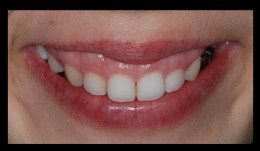

Upper anterior esthetic crown lengthening
Ignacio Sanz MartinFemale patient looking for a treatment to improve the appearance of her smile. -
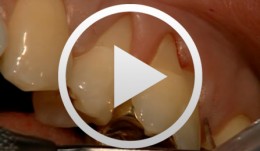

Regenerative Therapy for Multiple Recessions
Heinz, BerndContents - History - Emdogain Application - Incision - Periosteal Incision - Root Smoothing - Suture Technique - PrefGel Application Synopsis: Regenerative periodontal surgery with Emdogain enamel matrix protein: The goal of regenerative periodontal surgery is to rebuild destroyed periodontal structures. Bone transplants, bone replacement materials, and nonresorbable and resorbable membranes have been and still are being used. In a new therapeutic approach to periodontal regeneration, the root surface is conditioned using an enamel matrix protein derivative (Emdogain, Biora). The protein complex stimulates the regeneration of root cement, which in turn leads to the regeneration of bone and collagen fibers. Since the early 1980's, Professor Lars Hammerström's Swedish research team has performed extensive research and studies on this method and its mode of action. Emdogain is now used for treatment of vertical bone defects and furcation defects. The exposed root surface is first carefully scaled using handheld instruments or a rotating, fine-grain diamond drill. PrefGel EDTA suspension (Biora) is then applied for 2 minutes, then thoroughly rinsed with physiological saline solution. The EDTA suspension serves to remove the smear layer and opens the dentinal tubules, leading to improved binding of Emdogain to the root surface. Emdogain is applied to the blood- and saliva-free root surface immediately after rinsing. Finally, the wound is sutured closed. -
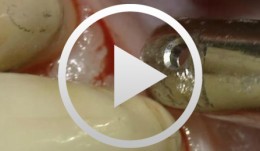

Access-Flap for Treatment of Aggressive Periodontitis
Beck, FrankContents. Aggressive periodontitis leads to early and extensive loss of periodontal supporting tissue. Controlling the infection is of serious importance to avoid further loss of attachment. The surgical procedure is difficult, especially if the tissue is already severely damaged. The challenge for the surgeon is to protect and conserve the tissue as much as possible. -
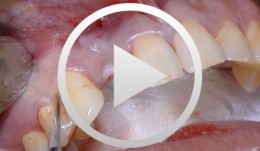

Combined implant treatment with soft and hard tissue management
Schlee, MarkusProcedure - Soft and hard tissue management - Implantodontic treatment - Case documentation Contents: - History - Patient hadn't seen a dentist for 15 years - Has been on Marcumar since developing a blood clot in 1997 - His general practitioner extracted teeth and performed conservative dentistry during the last year - Heavy smoker (30 cigarettes a day) - Prothrombin time (Quick's value): 40 - Premedication: Augmentan 750/125 tablets. -
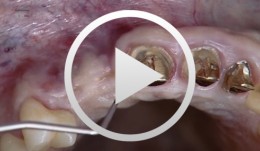

Implantation with Simultaneous Augmentation
Grunder, UeliProcedure: - Case evaluation - Incision technique - Implant placement - Membrane adjustment and fixation - Introduction of replacement material - Flap mobilization - Suture technique Contents: Implantation was desired for replacement of a missing upper canine tooth and the adjacent lateral incisor tooth. The initial case evaluation revealed a relatively narrow gap between these two teeth in addition to extensive hard and soft-tissue defects. We selected an incision technique that made it possible to do the augmentation work yet subsequently achieve a tension-free flap closure. Since the bony defect was large while the available space was limited, we had to go for the best possible compromise in regard to implant insertion. After the implants had been inserted, augmentation was carried out using a non-absorbable, titanium-reinforced membrane, bone replacement material, and an absorbable membrane. Extreme flap mobilization was needed to achieve flap closure. An optimal suture technique was used to complete the surgery. -


Immediate implant placement at site 21 with combination-graft closure
Iglhaut, Gerhard M. -
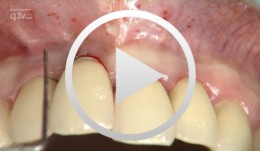

-
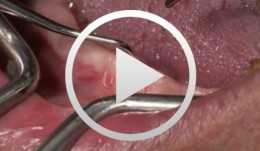

3D planning and template-guided implant insertion in the edentulous jaw
Kirsch, Axel / Ackermann, Karl-Ludwig / Neuendorff, GerhardContents: - Surgical procedures for anchoring a diagnostic guide - Inserting four provisional implants - Impression and bite registration, fabrication of the master cast - Tooth-setup for the temporary restoration - Registering the setup in a silicone index - Duplicating the setup in radiopaque resin for CT imaging - Implant planning using a 3D record of the CT image - Fabricating a transfer template based on the CAD treatment plan using the CAMLOG® Guide System - Inserting the guiding sleeves into the template - Fabricating the final restoration prior to inserting the implants - Vario SR abutments with Vario SR titanium copings for a passive fit - Fabricating a cast titanium framework to reinforce the restoration - Surgical procedures demonstrating the definitive implant insertion - Insertion of six implants for immediate loading - Providing a controlled-clearance fit between the implants and the denture base










